Results show enhanced growth, survival, feed utilization, immune responses and resistance to Vibrio parahaemolyticus infection
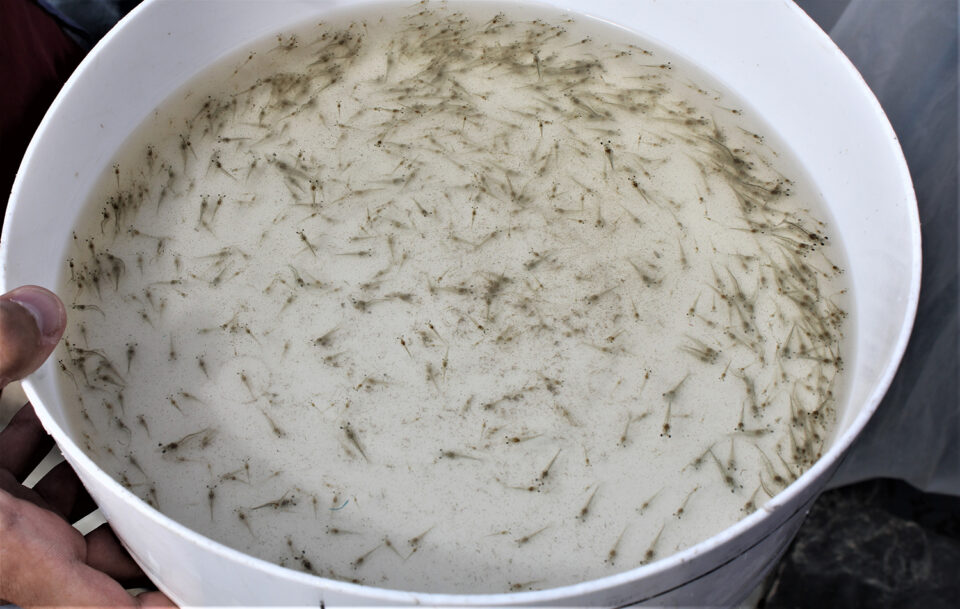
Spray-dried animal plasma (SDP) is a protein-rich animal blood byproduct obtained from abattoirs. Industrial production of SDP involves the separation of the plasma from blood cells by centrifugation, concentration by vacuum evaporation or filtration and spray-drying. SDP is usually prepared from either swine (spray-dried porcine plasma; SDPP) or cattle blood (spray-dried bovine plasma; SDBP). It contains diverse beneficial components, and as an animal feed protein source, SDP has long been proven to promote animal health.
The health-promoting properties of SDP are well-known in farmed animal production and the scientific evidence supporting its application is extensive, including enhancing growth performance, nutrient utilization, and feed intake, suppressing inflammation and disease incidence, and influencing gut microbiota in a positive manner.
Due to its rich protein content, SDP has been evaluated for application in aquatic feeds as a partial replacement of fishmeal with promising results in various species, including rainbow trout, tilapia, gilthead sea bream, pacu and others. These studies demonstrated that the beneficial effects of SDP in fish diets were in general similar to results observed in terrestrial animals. Some of the additional benefits of SDP reported in fish studies include enhanced immunity and improved intestinal morphology.
The effects of SDP on shrimp health are not well understood. To the best of our knowledge, information regarding the potential advantages of SDP in shrimp culture has been limited to one exploratory study published in a non-peer-reviewed source which concluded that diets supplemented with 1 to 3 percent SDP was able to increase the growth and survival rate of black tiger shrimp (Penaeus monodon) in laboratory conditions and that 6 percent SDP could improve the body weight and survival rate of Pacific white shrimp in a field trial.
This article – adapted and summarized from the original publication [Chuchird, N. et al. 2021. Effects of spray-dried animal plasma on growth performance, survival, feed utilization, immune responses and resistance to Vibrio parahaemolyticus infection of Pacific white shrimp (Litopenaeus vannamei)] – investigated the health-promoting effects of swine SDP in diets of Pacific white shrimp, with the objective of providing scientific evidence in support of the application of SDP in feed for Pacific white shrimp farming for sustainable aquaculture.
Study setup
This study was carried out at the Aquaculture Business Research Center (ABRC) laboratory, Faculty of Fisheries, Kasetsart University, Thailand. Three thousand Pacific white shrimp (Litopenaeus vannamei) postlarvae 9 (PL-9) from a commercial shrimp hatchery in Chachoengsao Province, Thailand were acclimatized in a 500 L fiberglass tank at 27 to 29 degrees-C and 25 ppt salinity for three days until they reached the PL-12 stage.
Five experimental diets were formulated with different concentrations of a commercial SDP (AP 820, APC Europe, Granollers, Spain): 0 (control), 1.5, 3, 4.5, and 6 percent SDP (or 0, 15, 30, 45, and 60 g/kg diet).
The study was divided into two experiments. In Experiment 1, the effects of dietary SDP on growth, survival, feed utilization, and immune responses were evaluated in healthy shrimp. The PLs were divided into five groups (four tanks/group and 80 shrimp/tank) and fed four times daily diets with porcine SDP at 0, 1.5, 3, 4.5 and 6 percent of the diet for 45 days.
In Experiment 2, the impact of SDP on resistance to Vibrio parahaemolyticus was assessed after an experimental infection challenge. In this experiment, the surviving shrimp from Experiment 1 were redistributed into six groups: four SDP groups as in Experiment 1 plus the positive and negative controls (four tanks/group and 30 shrimp/tank). They were then challenged with V. parahaemolyticus by immersion at 105 colony-forming units (CFU)/mL and were fed with the same diets for another four days.
For detailed information on the design of each of the two experiments; animal husbandry; preparation of the experimental diets tested; immunology and histopathology assessments; immersion challenge; and statistical analyses, refer to the original publication.
Results and discussion
Results of our study showed that the survival rates of the SDP-fed shrimp at the end of both Experiment 1 and 2 were significantly higher than the control shrimp. Shrimp feed supplemented with swine SDP, especially at 3 to 6 percent of the diet, could improve the growth performance, survival, feed utilization, immune responses, and reduce the mortality caused by V. parahaemolyticus infection. The effective dose of SDP for improving the overall health status of the Pacific white shrimp was mainly in agreement with those reported in previous swine research (5 to 8 percent SDP). Various immune parameters (total hemocyte count and phagocytic, phenoloxidase and superoxide dismutase activities) of the shrimp fed 3 to 6 percent SDP diets also showed significant enhancement compared to the control.
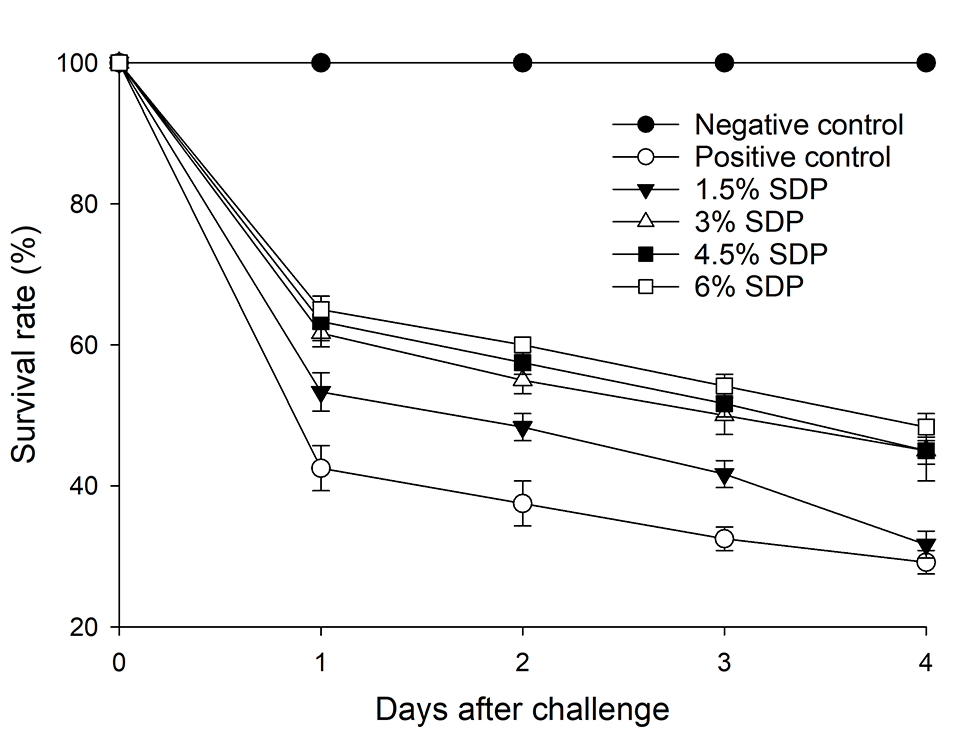
Multiple modes of action of SDP have been proposed for the observed positive results in various species regarding improved growth performance and feed utilization. These could be partly associated with the high nutritional value and high digestibility of SDP, the improved intestinal morphology including increased villi [internal intestinal protrusions that maximize absorption area] height and enhanced digestive enzyme activities. In addition, some studies have reported that more dietary protein was utilized for growth in the tested animals.
In Experiment 2, the survival rates of the 3 to 6 percent SDP-fed shrimp were significantly higher than the positive control at day 4 after the immersion challenge. Likewise, the histopathological study revealed milder signs of bacterial infection in the hepatopancreas of the 3 to 6 SDP groups compared to the challenged positive control and the 1.5 percent SDP groups. Overall, the L. vannamei shrimp fed diets with SDP, especially at 4.5 to 6 percent of their diet, showed significant improvement in overall health conditions and better resistance to V. parahaemolyticus infection.
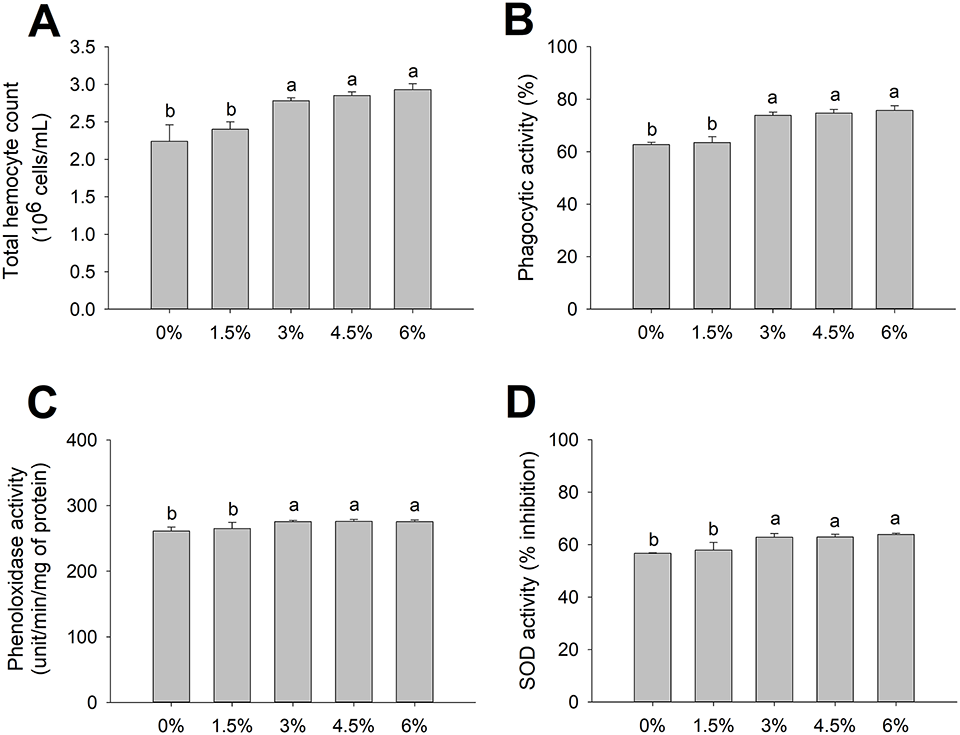
It is widely accepted that the health-promoting effect of SDP is mainly attributed to the immunomodulatory property of SDP on the intestinal barrier and its anti-inflammatory activities suppressing the production of pro-inflammatory compounds. The continuous exposure of the intestinal mucosa to bacterial pathogens or toxins can cause chronic overstimulation of the mucosal immune system, thereby impairing intestinal barrier function and resulting in poor nutrient absorption. SDP administrations to various terrestrial animals have been shown to reduce mucosal immunity over-activation, which helps maintain the functional gut barrier and allows for more energy available for the growth as well as other productive functions.
Our findings reveal that swine SDP has positive effects on the health of Pacific white shrimp agrees with the results of several previous studies with various terrestrial animal species.
Although several biologically active compounds can be found in SDP, it is commonly believed that immunoglobulins [antibodies] are the main active component responsible for the observed growth-promoting activity of the SDP. Other functional components in SDP – like transferrin, bioactive peptides, growth factors, cytokines, and other compounds – may also contribute to the health benefits observed in multiple species fed diets with SDP.
We also determined that SDP increased circulatory immune responses in the shrimp. The reason why SDP possesses both immune-suppressing and immune-stimulating activities is not well-understood, but it is possibly associated with a complex interplay between the site of action, immunoglobulins and other bioactive substances in the SDP, the immune status of the animals and other factors.
The lower degree of histopathological changes in the hepatopancreas of SDP-fed shrimp we observed in our study supports the protective action of SDP from bacterial infection. Unsurprisingly, the benefit of SDP in improving the survival rate was more prominent in the V. parahaemolyticus-challenged shrimp (Experiment 2) than the healthy shrimp (Experiment 1). Greater efficacy of SDP also observed in terrestrial animals reared under poor hygiene conditions compared to a cleaner environment, supporting the speculation that the mode of action of SDP might be related to its anti-pathogen and anti-inflammatory activities.
Perspectives
Overall, results of our study proved that swine spray-dried animal plasma in L. vannamei diets can improve growth performance, survival, feed utilization, immune responses, and reduce the mortality of V. parahaemolyticus-infected Pacific white shrimp, and probably others as well, thereby helping reduce the unnecessary uses of undesirable compounds.
Now that you've reached the end of the article ...
… please consider supporting GSA’s mission to advance responsible seafood practices through education, advocacy and third-party assurances. The Advocate aims to document the evolution of responsible seafood practices and share the expansive knowledge of our vast network of contributors.
By becoming a Global Seafood Alliance member, you’re ensuring that all of the pre-competitive work we do through member benefits, resources and events can continue. Individual membership costs just $50 a year.
Not a GSA member? Join us.
Authors
-
Niti Chuchird, Ph.D.
Corresponding author
Faculty of Fisheries, Department of Fishery Biology, Kasetsart University, Chatuchark, Bangkok, Thailand -
Tirawat Rairat, Ph.D.
Faculty of Fisheries, Department of Fishery Biology, Kasetsart University, Chatuchark, Bangkok, Thailand
-
Arunothai Keetanon
Faculty of Fisheries, Department of Fishery Biology, Kasetsart University, Chatuchark, Bangkok, Thailand
-
Putsucha Phansawat
Faculty of Fisheries, Department of Fishery Biology, Kasetsart University, Chatuchark, Bangkok, Thailand
-
Chi-Chung Chou, Ph.D.
Department of Veterinary Medicine, College of Veterinary Medicine, National Chung Hsing University, Taichung, Taiwan
-
Joy Campbell, Ph.D.
APC LLC, Ankeny, Iowa USA 50021
Tagged With
Related Posts
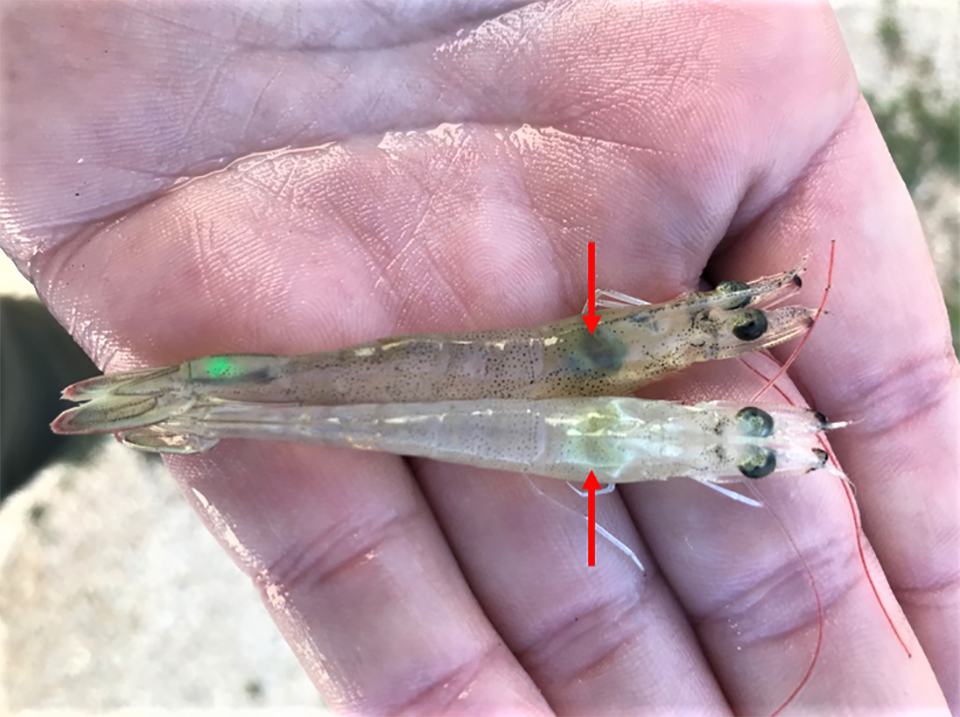
Health & Welfare
AHPND is a chronic disease in Pacific white shrimp from Latin America
There is a new phase of infection for Acute Hepatopancreatic Necrosis Disease on Latin American shrimp farms, a contrast to observations in Southeast Asia.
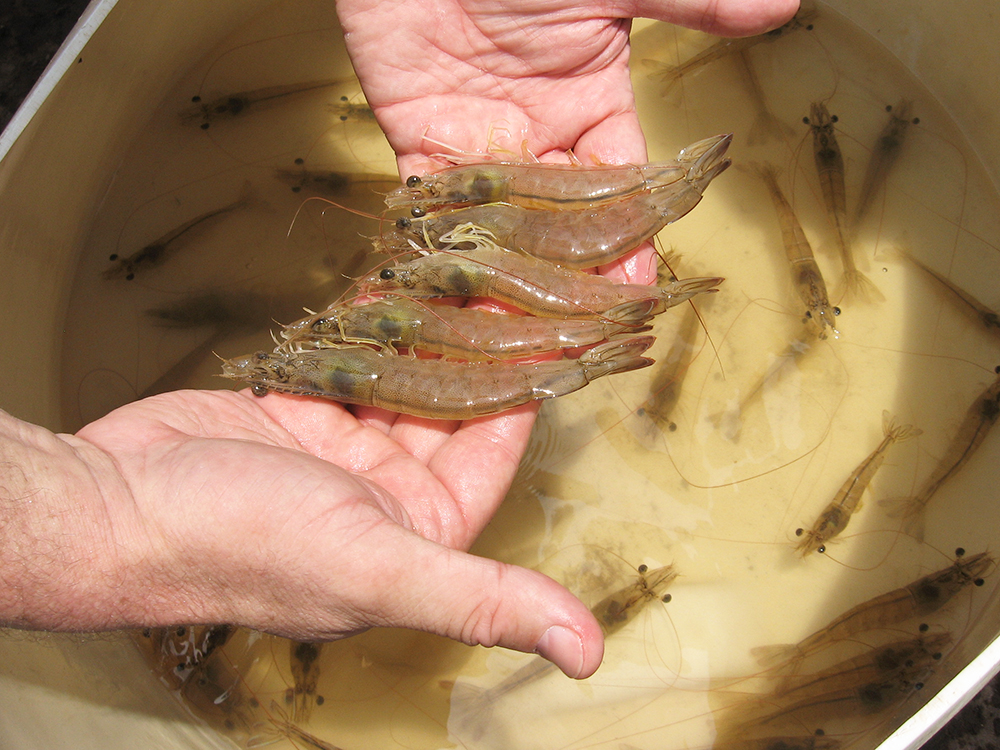
Health & Welfare
Non-invasive diagnostic tool developed for shrimp disease EMS
The presence of AHPND-Vibrio parahaemolyticus can be detected both in fecal DNA samples and in the enriched bacterial broth with samples of enrichment broth showing increased sensitivity.
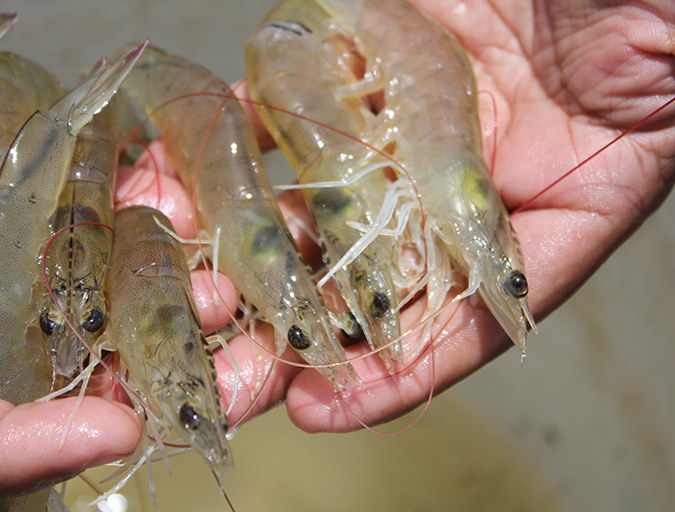
Health & Welfare
Probiotics benefit Pacific white shrimp challenged with AHPND
A study was conducted to measure the effects of commercial probiotics on Pacific white shrimp in a standardized AHPND challenge model under controlled laboratory conditions. Results show that the probiotics treatments by themselves have beneficial effects, such as higher survival and histological signs of hepatopancreas regeneration.
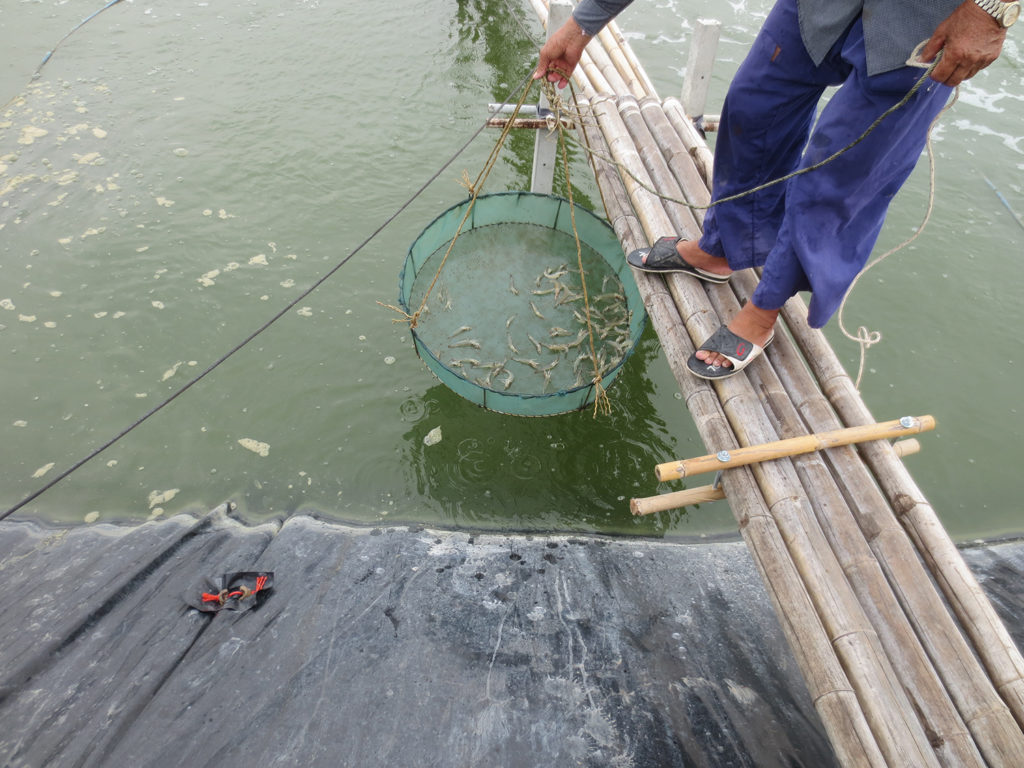
Health & Welfare
The unmet promise of pondside PCR
A new generation of technology, portable PCR, offers potential for affordable, immediate, pondside diagnosis in easy-to-use handheld kits. But will it live up to the hype?



